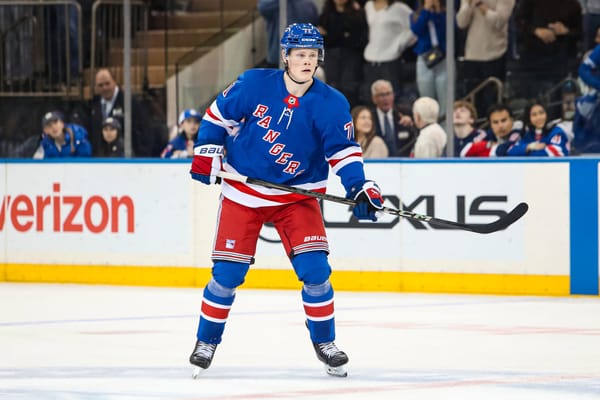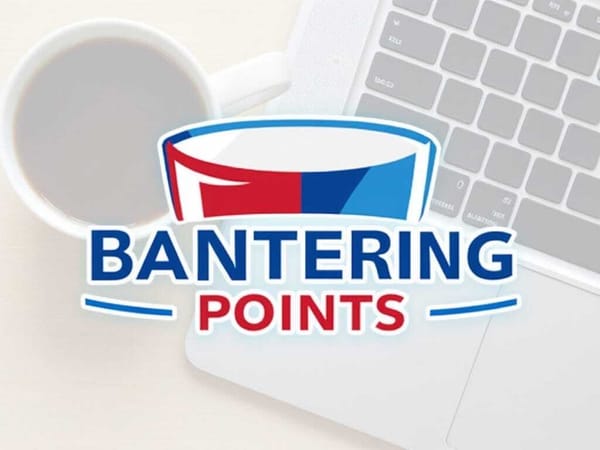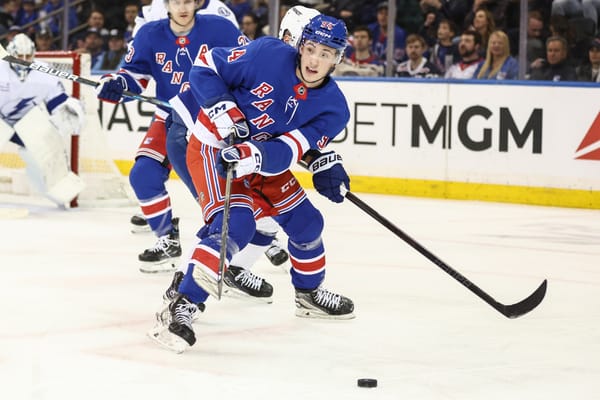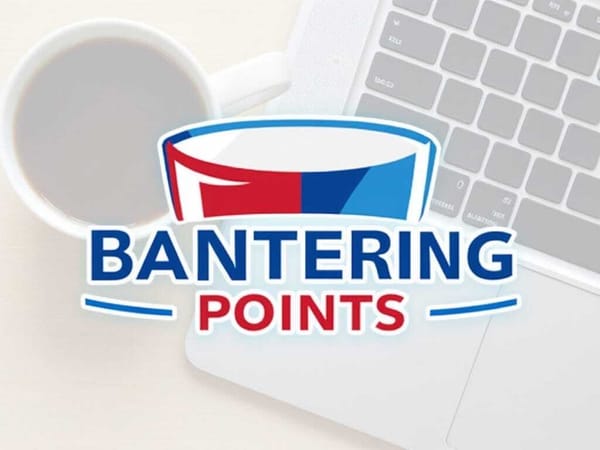Is Adam McQuaid Actually Bringing out the Best In Brady Skjei?
David Quinn is a huge fan of Adam McQuaid, and more specifically when he plays with Brady Skjei. The Blueshirts’ bench boss addressed the media — as he always does on gameday — prior to Thursday’s 4-3 victory over the Chicago Blackhawks, and he had some interesting things to say.
He certainly gives us that defensive presence, and one of the things I think that’s underrated about Adam is he can make an outlet pass. And I think just having that security blanket, so to speak, as a partner has allowed Brady to play a better game.” - Quinn on Brady and McQuaid
— New York Rangers (@NYRangers) January 17, 2019
The assessment is interesting, as Quinn describes McQuaid as a calming influence, and someone who the Rangers missed when he was injured. Furthermore, he heralded McQuaid as a “security blanket” who allows Skjei to play a better overall game.
My first reaction to hearing this was befuddlement, and I’ll be honest; this moment was at top of mind.
But in fairness and for the sake of education, I wanted to dig into the data and see what was up. There have been a lot of thoughts on McQuaid, why he was acquired in the first place and so on. He’s a pending unrestricted free agent, and if he truly is making Skjei better, that would be great for his trade value. But the $2.75 million question is, “is Adam McQuaid actually bringing out the best in Brady Skjei?”
The short answer is no, but that is qualified with the statement that the pairing has been unlucky and should have some better results. But by and large what we’ve seen from the pair is a pretty good tell of what they are.
McQuaid has been Skjei’s most frequent partner this season — 285 minutes spent together at 5v5 which makes them the Rangers’ second most common defense pair — and the actual results haven’t been too pretty.
Skjei has been a part of it too; it’s not just McQuaid on his own. Together, they rank last in Corsi for percentage and goals for percentage compared to the rest of the Rangers’ defense pairs. But their actual goals for percentage and expected don’t exactly line up; with the quality of their chances for and against in mind, they’re actually second in expected goals share. Their 98.31 PDO, which considers both shooting percentage and save percentage while they’re on the ice, adds some context to why those numbers don’t line up — they haven’t been that lucky.
From a with and without perspective, it’s hard to quantify McQuaid’s impact as he’s spent just 59 minutes away from Skjei whereas Skjei has spent nearly 500 minutes away from McQuaid.
This makes things complicated, because Skjei’s overall results could be distorted by being given new partner after new partner. It could also be a result of him being in over his head, or a combination of the two.
Because of this, I wanted to see the pair’s results when compared to other popular Ranger defense pairings. This season there are only six pairings that have played at least 100 minutes together 5v5 — Skjei happens to be apart of three of these pairings — and here are the results.
Based on the results above, there’s a strong argument that Skjei and Kevin Shattenkirk is a pairing to try again. The duo has only 53 minutes of 5v5 time together, but it did well in a small sample and a PDO of 96.90 suggests they were also unlucky. This makes even more sense in the interim since Fredrik Claesson, Shattenkirk’s frequent partner, is sidelined with injury.
For the second season in a row, the Rangers have primarily put Skjei in a blender with his pairings. I talked about this at length when I defended his contract extension during the summer. Here’s one snippet that I think is relevant now.
Right away, the time on ice per partner should stick out. In his freshman year, Skjei spent 400+ minutes with his primary partner, 200+ with his secondary partner, and over 100+ with his tertiary partner. His sophomore season was all over the place, skating at least 100 minutes with seven different partners.
This usage is brutal for a player in their second season and even worse when you see some of the partners he was with. There’s Kevin Shattenkirk, who was playing with an injury, Marc Staal, and fellow rookie Neal Pionk. Sticking with those three, you see a respective PDO of 98.96, 98.67 and a 93.77.
I say this not to absolve Skjei entirely, but defense is a position where familiarity with a partner is important, and he’s been stopped and started a few times with McQuaid being the most recent individual to stick.
The Rangers are a terrible team in terms of shot share, and scrambling things — except Staal and Pionk — doesn’t help matters.
Shot share
— Sean Tierney (@ChartingHockey) January 18, 2019
There was once a Lebreton Flats sized gap between OTT and the rest. ANA and NYR have had a Rendezvous, welcoming OTT back a bit from the outskirts. pic.twitter.com/JduDqAeFCU
If I were to put a positive spin on Quinn’s comments, it would be that the words are good public relations. Skjei is a player who is expected to be a key piece of the rebuild. McQuaid is 32 and set to become a free agent. Him being a steadying force to help turn around someone’s game would be a great selling point to a playoff contender who is looking to add depth.
As Phil pointed out in a piece earlier this week, there aren’t a lot of desirable right handed defensemen set to be available, so the Rangers may be able to leverage that. I don’t disagree with the notion that the pairing has been unlucky, and the results could be better, but it isn’t as if the pair’s PDO is 88. A PDO of 98.31 suggest they are pretty much what they are, for better or worse.
And because I like charts, here’s one from Micah Blake McCurdy aka @IneffectiveMath
For a negative spin, it would be that their evaluation of defensemen is truly questionable, from player acquisitions to in-game decisions like this.
This may seem like nitpicking and ill timed given the team has won back to back games, but the long term future of the team is more important. There is no point wasting Skjei’s time — if it is clear that things aren’t working — on a defender who isn’t in the team’s future plans. His deployment has been mixed up enough over the last two years, and I don’t know what the Rangers expect to learn from it. And furthermore, when someone makes a statement that a player is bringing out the best in a player, there has to be measurable results.
How the Rangers evaluate their defensemen is unknown, because conventional wisdom would say that upon returning from injury Neal Pionk should be partnered with someone other than Marc Staal, but I am not so sure of that. Maybe the Rangers have internal metrics which highlight the impact of McQuaid on Skjei, and if that were the case I would be shocked to see what they are.
Stats via Corsica.hockey and Natural Stat Trick unless otherwise noted.





